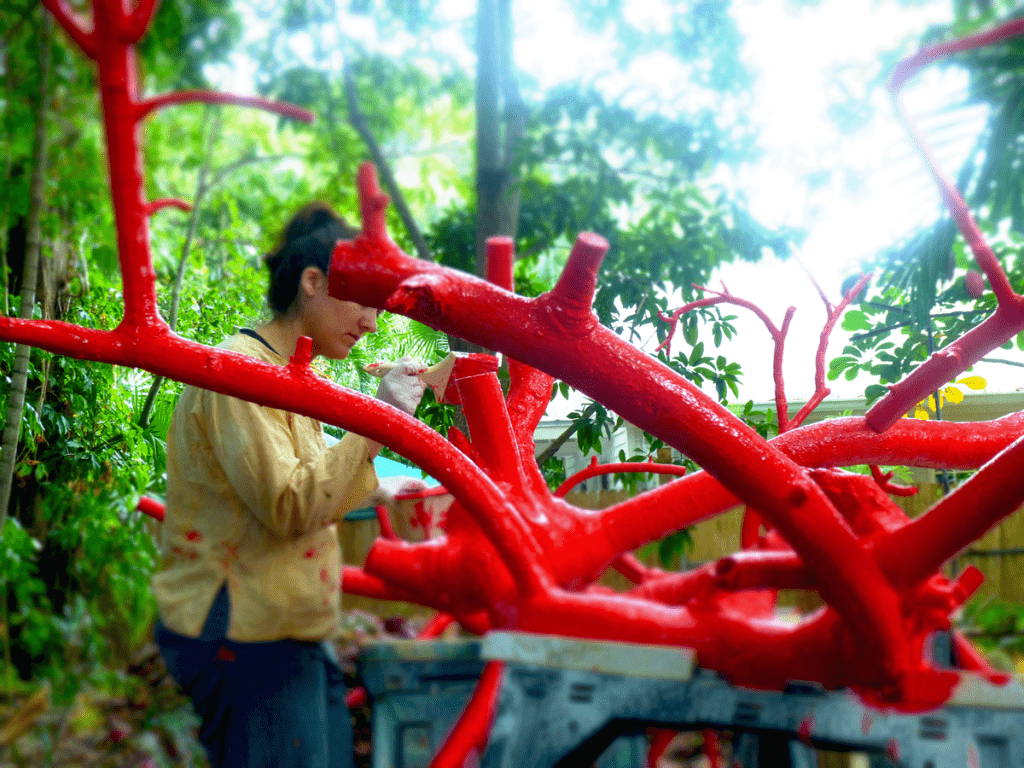Work in progress for Deering Estate, Miami
Working on the sculpture “Tiger; Fire; River“. It will be exhibited at the “Speak Now” Exhibition, curated by Ralph Provisero

Working on the sculpture “Tiger; Fire; River“. It will be exhibited at the “Speak Now” Exhibition, curated by Ralph Provisero

We were walking along the edge of the ocean’s foam apron, water chasing our bare feet. Seaweed piled up in little pyramids on the sand, oozing sulfurous vapor that bit into the fresh air. With his big hands this hirsute man spoke as he gestured towards the skyline, saying that it is here in nature that he finds his savage muse.
In sculpture if you become too academic in poses and style, you are making an absentee of nature and thus life becomes absent from your work. We must unfreeze sculpture, life is the thing, everything is in it, and life is movement.
You should be at the order of Nature. A sculptor should take from life the movements that he observes but he should not impose them. Obey nature and do not command her and know that there is no recipe to improve nature, for it will become a lie. The secret is to ‘see’ her and not to just look at her.
The wind picked up and carried his words away but did not hinder his monologue.
What we commonly call ‘ugliness’ in nature can become full of great beauty in art. For the great artist everything in nature has character and that which has character is beautiful. That which is considered ‘ugly’ in nature in fact has more character for its inner truth shines through more so than that which we consider ‘beautiful’ in nature. Capturing this power of character in art makes the sculpture strong with value. There is nothing ugly in art except that which is without character, that lacks inner truth. That is why Baudelaire could make the festering corpse about love, why Velasquez could render the dwarf so touching.
As we stood under the shade of the palm trees he looked up and said that he is the confidant of these trees and this ocean; they talk to him like old friends. But his eyes now caressed the golden bodies of the sunbathers embedded in the sand; their limbs oiled and stretched to harvest every single ray of light.
Do you see their living detail?
Somehow through the years I have stopped paying attention to the loud tourist but with new eyes I scanned their bodies. The surface of their skin’s slight projections and depressions, the body itself a multitude of almost imperceptible roughness. Every body curved into an attitude, a story.
*Grunfeld V. Frederic, “Rodin. A Biography” Henry Holt. 1987. *Rodin, A “Rodin on Art and Artists” Dover Publications. 1983. |
The Royal Poincianas are in full, blazing crimson bloom and, as I peer over my chipped porcelain teacup inhaling its dark aroma, the conversation starts.
It is a monologue that drifts over the static channels of more than a century but when he speaks his beard moves like a stiff, red, thatch roof. Barely two inches taller than me, we look at each other through a fog–not because of the curtain of time–but because of our weak eyes. Our sight is due to the unavoidable curse of a sculptor that works many hours transfixed and bent over his material in low light.
His hands–once called une main d’une prodigieuse vitesse–are moving restlessly when he speaks about how the power of observation should always be practiced…look at an object and fix that image in your mind and try to retain its memory as long as possible before you sketch it. When you are carving your object, never see the form in length but that of its width; a surface is always the extremity of the volume. He will lean forward in his chair to make very clear his point that it is all about the projection of the interior volumes. In each swelling of the torso or the limbs a suggestion of outward thrust is made by a muscle or a bone that is buried deep under the skin. Oh, and for god sakes do not brood over your failures too long for there is not much time; an intense nervous excitement should always drive you back into the studio and into your work but there is no need to hurry.
Wait a minute–what do you mean? I have to work with nervous excitement and fast hands; or there’s no hurry, so take it easy? Which one is it?
His fingers are now rolling a clay coil absentmindedly and he slowly utters that, a sculptor should be wild about working, getting up early, sketching non-stop, studying the masters, never be distracted for so much as a minute! But you always have time to make a beginning once you are sure of your subject; a sculptor can establish his or her reputation with a single piece of sculpture.
A silence falls between us that becomes filled with the songs of the cicadas, both lost in thought. I asked him if he will come back tomorrow?
*Grunfeld V. Frederic, “Rodin. A Biography” Henry Holt. 1987. *Rodin, A “Rodin on Art and Artists” Dover Publications. 1983. |